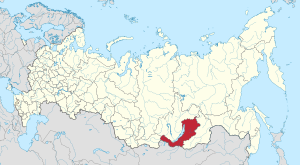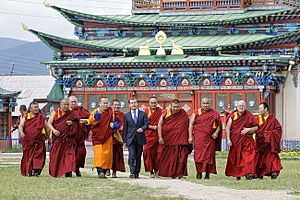Buryatia facts for kids
Quick facts for kids Republic of BuryatiaРеспублика Бурятия (Russian) Буряад Улас (Buryat) |
|||||
|---|---|---|---|---|---|
| — Republic — | |||||
|
|||||
|
|
|||||
|
|||||
| Political status | |||||
| Country | Russia | ||||
| Federal district | Far Eastern | ||||
| Economic region | East Siberian | ||||
| Established | 30 May 1923 | ||||
| Capital | Ulan-Ude | ||||
| Government (as of February 2017) | |||||
| • Head | Alexey Tsydenov | ||||
| • Legislature | People's Khural | ||||
| Statistics | |||||
| Area (as of the 2002 Census) | |||||
| • Total | 351,300 km2 (135,600 sq mi) | ||||
| Area rank | 15th | ||||
| Population (2010 Census) | |||||
| • Total | 972,021 | ||||
| • Rank | 54th | ||||
| • Density | 2.77/km2 (7.2/sq mi) | ||||
| • Urban | 58.4% | ||||
| • Rural | 41.6% | ||||
| Time zone(s) | IRKT (UTC+09:00) | ||||
| ISO 3166-2 | RU-BU | ||||
| License plates | 03 | ||||
| Official languages | Russian; Buryat | ||||
| Official website: http://egov-buryatia.ru/ | |||||
The Republic of Buryatia is a special part of Russia, like a state or province. It's located in the Siberian area, which is a huge region in Russia. Buryatia is part of the Far Eastern District, which includes ten other similar areas. It also shares a border with the country of Mongolia.
Contents
History of Buryatia
Early History and Mongol Rule
Long ago, the Buryat people were closely connected to the Mongols. This was because they lived near each other and traded a lot. They also shared a similar culture. Because of this, the Buryats were often ruled by Mongol empires.
For example, the Xiongnu Empire ruled them from 209 BC to 93 CE. Later, Kublai Khan's Mongol Empire (1206-1368) and the Northern Yuan Empire (1368-1691) also controlled the area. Other Mongol tribes lived in Buryatia during these times too.
Russian Arrival and Modern Times
Europeans from Russia first arrived in the Buryatia area in the 1600s. They were looking for valuable furs and gold. In the 1920s, the region faced a lot of conflict during the Russian Civil War.
To bring order, the Buryat-Mongolian Autonomous Soviet Socialist Republic was formed in 1923. Its size and name changed several times while it was part of the Soviet Union. In 1990, Buryatia started to govern itself more. When the Soviet Union collapsed, it became the Republic of Buryatia in 1992. It remains a republic within Russia today.
Geography and Climate
Where is Buryatia?
Buryatia is located in the south-central part of Siberia. This means it has a subarctic climate. This type of climate brings very long and cold winters. Summers are usually short and mild. The region does not get a lot of rain.
Landscape and Nature
The land in Buryatia is mostly mountainous. Lake Baikal, the world's largest freshwater lake, is partly located here. This lake is incredibly deep and holds a huge amount of the world's fresh water.
Many different animals and birds live in the area. You might see different ones depending on the season. Buryatia is also rich in natural resources. It has many valuable minerals like gold, tungsten, uranium, and zinc.
People and Culture
Population and Cities
After the Soviet Union ended, Buryatia's population went down for a while. However, it is now growing again. More than half of the people in Buryatia live in cities and towns. Most of these city dwellers live in the capital city, Ulan-Ude.
Ethnic Groups and Religions
About one-third of the people in Buryatia are ethnic Buryats. The other two-thirds are mostly ethnic Russians. Most ethnic Buryats follow a religion that combines Buddhism with Shamanism. Shamanism is a belief system that involves worshipping spirits and nature. Most ethnic Russians, on the other hand, practice Orthodox Christianity.
Languages Spoken
Russian is the main language used and taught in Buryatia. However, the Buryat language is still taught in some schools. It is also commonly spoken at home by many families.
Economy and Tourism
Main Industries
Buryatia's economy largely depends on farming. This includes growing crops and raising animals. Mining minerals also plays a big part in the economy. The region also builds military equipment and machines.
Tourism and Lake Baikal
Lake Baikal is a very important place for tourism. It is recognized as a UNESCO World Heritage Site. Many people visit Lake Baikal to see its beauty. Buddhist sites in Buryatia also attract tourists. These visitors help the local economy.
Government and Politics
How Buryatia is Governed
The leader of the Republic of Buryatia is called the Head of Buryatia. The public votes for the Head every five years. The republic's parliament is called the People's Khural. The lawmakers in the People's Khural are also chosen by public vote every five years.
Most of these lawmakers are currently from the United Russia party. This party is the main ruling party in Russia. Buryatia used to be part of the Siberia Federal District. It was later moved to the current Far Eastern Federal District.
Travel and Transportation
Key Transport Routes
Buryatia is located along two very important routes: the Trans-Siberian railway and the Trans-Siberian Highway. These major railway and road links connect Moscow in western Russia all the way to Asia. They also help connect Buryatia with the rest of Russia.
Airports and Flights
The republic has several airports. One of them is Baikal International Airport. Flights from these airports connect Buryatia to cities that are further away. This makes it easier for people to travel to and from the region.
Images for kids
-
View of Lake Baikal in Buryatia
-
The village of Baikalskoe on the northern shores of Lake Baikal
-
The peninsula of Svyatoy Nos, Lake Baikal.
-
Dmitry Medvedev at a Buddhist temple in Buryatia
See also
 In Spanish: Buriatia para niños
In Spanish: Buriatia para niños
















